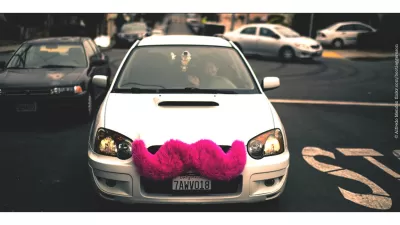Planopedia
Clear, accessible definitions for common urban planning terms.
What Are Transportation Network Companies?
Transportation Network Companies (TNCs), provide on-demand transportation services through app-based platforms to create a new level of convenience for riders—and a host of challenges for policymakers and regulators.

In the last decade, tech-based start-ups took the traditional taxi model and combined it with online platforms to create a new type of on-demand transportation option that promised unprecedented convenience for users. The meteoric rise of such services, run by Transportation Network Companies (TNCs), upended the tax industry in many cities and left policymakers struggling to retroactively impose regulations and limit the effects of the new sector on public space, traffic, and public transit.
Also known as ride-hailing or rideshare companies, TNCs rely on mobile phone apps to provide on-demand transportation and delivery services. Unlike traditional taxi businesses, TNCs do not maintain their own fleets of vehicles, but contract individual drivers in cars and price rides dynamically based on driver availability, rider demand, and other factors. Customers request a ride through an app and are connected to a driver, often at a lower cost than traditional taxi services. It should be noted that, while TNC is the most commonly used term among planners, the media more frequently uses 'ride-hailing companies' or, more inaccurately, 'ridesharing companies.' While the business model at first relied more heavily on rides shared between two or more users traveling similar routes, COVID-19 restrictions led to a suspension of shared rides.
While TNCs promised their services would revolutionize urban transportation which, in many ways, they did), complaints from the taxi industry and labor advocates drove cities to create policies that would regulate and limit this new, private mobility service that was having a major effect on public amenities.
In 2014, Seattle became the first city to cap the number of TNC drivers, but the cap was rescinded by referendum a month later. Later that year, Colorado's state legislature enacted regulations that allowed TNCs to continue operating under certain conditions. Other cities and states followed. In 2015, California addressed labor concerns in the ride-hailing industry by passing a law requiring TNCs to hire drivers as employees and provide benefits. Uber, Lyft, and others in the industry have consistently resisted attempts to legislate more rights for their workers. A 2020 California ballot proposition, heavily funded by the industry, attempted to supersede the prior law and once again make 'gig workers' independent contractors. Although the proposition passed, a state court later invalidated the measure, ruling the proposition unconstitutional and therefore unenforceable.
Despite their promises to solve urban transport problems, TNCs have largely failed to live up to the expectations of both their investors and city officials. While TNCs claimed to reduce car trips and lower carbon emissions in cities, they have had the opposite effect, increasing congestion and emissions through a practice called 'deadheading,' or driving around waiting for clients. Although TNCs promised reduced mileage thanks to pooled rides, according to one 2020 study, TNC customers 'at least doubled' their vehicle miles traveled. That study showed a 97 percent increase in VMT in Chicago and a 157 percent increase in Boston.
The rise of TNCs counterintuitively led to an increase in car ownership, with data showing a rise in vehicle registrations in cities with TNC services. And while TNCs boasted a reduction in drunk driving thanks to their services, data show no significant impact on drunk driving fatalities in areas where the services were introduced.
Research also shows that rather than replacing personal car rides, the availability of ride-hailing induced people to take driving trips that would have been taken by bike, on foot, or by transit—or not taken at all. In 2017, Planetizen reported on a UC Davis study that first quantified the effects of ride-hailing on mode share, indicating that "services like Uber and Lyft attract passengers away from public transit, biking, and walking, in addition to serving as a complementary mode (e.g., for commuter rail)." Rather than serving as a complement to public transit, TNCs have been shown to harm transit ridership as users choose ride-hailing instead of, not in conjunction with, transit services. A 2019 study found that app-based ride-hailing corresponded with a 12.7 percent decline in bus ridership in San Francisco. Meanwhile, the availability of ride-hailing increased congestion in some unlikely settings. In 2019, a study found that UCLA students took 11,000 rides each week without ever leaving campus.
In addition to increasing reliance on private rides and adding to traffic, the TNC business model poses a challenge for curb management. In response to the high volume of ride-hailing vehicles blocking curbside space, some cities are employing tech to monitor and regulate curb space and parking, in some cases implementing designated drop-off zones in an effort to mitigate congestion and improve safety for riders.
Since 2018, TNCs have expanded the scope of their services by acquiring bike share and e-scooter companies, hoping to provide a comprehensive, multi-modal transportation platform and increase their market share.































